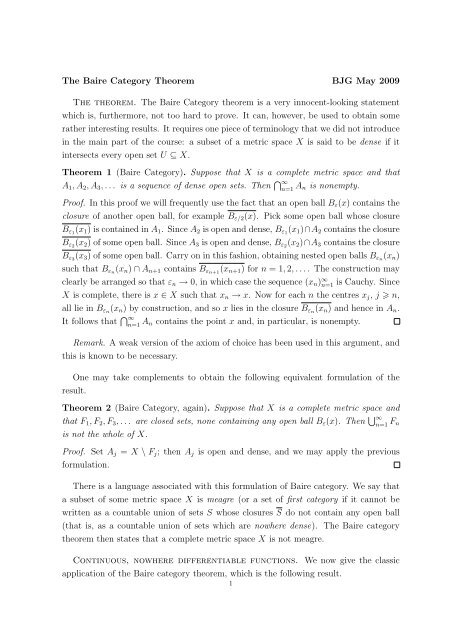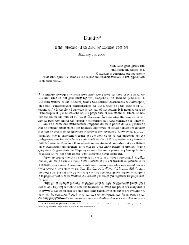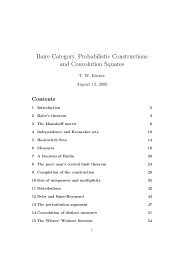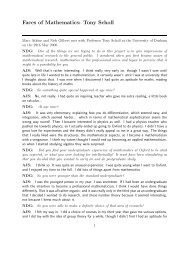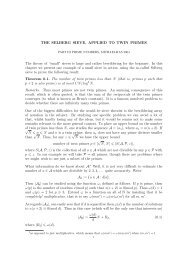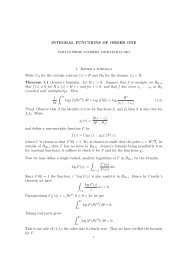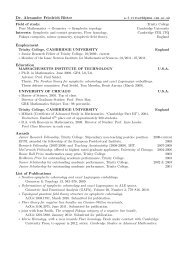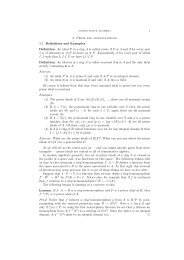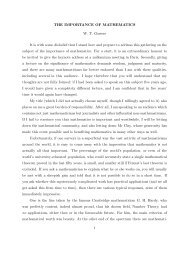The Baire Category Theorem BJG May 2009 The theorem. The ...
The Baire Category Theorem BJG May 2009 The theorem. The ...
The Baire Category Theorem BJG May 2009 The theorem. The ...
You also want an ePaper? Increase the reach of your titles
YUMPU automatically turns print PDFs into web optimized ePapers that Google loves.
<strong>The</strong> <strong>Baire</strong> <strong>Category</strong> <strong>The</strong>orem <strong>BJG</strong> <strong>May</strong> <strong>2009</strong><br />
<strong>The</strong> <strong>theorem</strong>. <strong>The</strong> <strong>Baire</strong> <strong>Category</strong> <strong>theorem</strong> is a very innocent-looking statement<br />
which is, furthermore, not too hard to prove. It can, however, be used to obtain some<br />
rather interesting results. It requires one piece of terminology that we did not introduce<br />
in the main part of the course: a subset of a metric space X is said to be dense if it<br />
intersects every open set U ⊆ X.<br />
<strong>The</strong>orem 1 (<strong>Baire</strong> <strong>Category</strong>). Suppose that X is a complete metric space and that<br />
A1, A2, A3, . . . is a sequence of dense open sets. <strong>The</strong>n ∞<br />
n=1 An is nonempty.<br />
Proof. In this proof we will frequently use the fact that an open ball Bε(x) contains the<br />
closure of another open ball, for example Bε/2(x). Pick some open ball whose closure<br />
Bε1(x1) is contained in A1. Since A2 is open and dense, Bε1(x1)∩A2 contains the closure<br />
Bε2(x2) of some open ball. Since A3 is open and dense, Bε2(x2)∩A3 contains the closure<br />
Bε3(x3) of some open ball. Carry on in this fashion, obtaining nested open balls Bεn(xn)<br />
such that Bεn(xn) ∩ An+1 contains Bεn+1(xn+1) for n = 1, 2, . . . . <strong>The</strong> construction may<br />
clearly be arranged so that εn → 0, in which case the sequence (xn) ∞ n=1 is Cauchy. Since<br />
X is complete, there is x ∈ X such that xn → x. Now for each n the centres xj, j n,<br />
all lie in Bεn(xn) by construction, and so x lies in the closure Bεn(xn) and hence in An.<br />
It follows that ∞<br />
n=1 An contains the point x and, in particular, is nonempty.<br />
Remark. A weak version of the axiom of choice has been used in this argument, and<br />
this is known to be necessary.<br />
One may take complements to obtain the following equivalent formulation of the<br />
result.<br />
<strong>The</strong>orem 2 (<strong>Baire</strong> <strong>Category</strong>, again). Suppose that X is a complete metric space and<br />
that F1, F2, F3, . . . are closed sets, none containing any open ball Bε(x). <strong>The</strong>n ∞<br />
n=1 Fn<br />
is not the whole of X.<br />
Proof. Set Aj = X \ Fj; then Aj is open and dense, and we may apply the previous<br />
formulation.<br />
<strong>The</strong>re is a language associated with this formulation of <strong>Baire</strong> category. We say that<br />
a subset of some metric space X is meagre (or a set of first category if it cannot be<br />
written as a countable union of sets S whose closures S do not contain any open ball<br />
(that is, as a countable union of sets which are nowhere dense). <strong>The</strong> <strong>Baire</strong> category<br />
<strong>theorem</strong> then states that a complete metric space X is not meagre.<br />
Continuous, nowhere differentiable functions. We now give the classic<br />
application of the <strong>Baire</strong> category <strong>theorem</strong>, which is the following result.<br />
1
2<br />
<strong>The</strong>orem 3. <strong>The</strong>re is a continuous function f : [0, 1] → R which is not differentiable<br />
at any point in (0, 1).<br />
In fact we shall show, in a certain sense, that “most” continuous functions are nowhere<br />
differentiable. Indeed the plan of the proof is to view the continuous functions C[0, 1] as<br />
a complete metric space X, and then to show that the functions which are differentiable<br />
at some point in (0, 1) form a meagre subset of it.<br />
We have already stated how X = C[0, 1] may be viewed as a metric space: the<br />
distance d(f, g) between two continuous functions f, g : [0, 1] → R is defined to be<br />
f − g∞ := sup |f(x) − g(x)|.<br />
x∈[0,1]<br />
It is easy to check that this distance function does define a metric on X.<br />
Proposition 1. X is a complete metric space.<br />
Proof. This is, essentially, a <strong>theorem</strong> you already know in disguise: the result that a<br />
uniform limit of continuous functions is continuous. Here is a sketch proof. Suppose<br />
that (fn) ∞ n=1 is a Cauchy sequence. This means that d(fn, fm) → 0 as n, m → ∞. In<br />
particular the sequence (fn(x)) ∞ n=1 is a Cauchy sequence of reals for each fixed x ∈ [0, 1],<br />
and therefore it tends to a limit which we call f(x). We must now show (i) that f is<br />
continuous, and (ii) that d(fn, f) → 0 as n → ∞. To establish (i), let x ∈ [0, 1] and<br />
suppose that ε > 0. Choose n large enough that d(fn, fm) ε/3 for all m n. Since fn<br />
is continuous, there is some δ > 0 such that |fn(x) − fn(y)| ε/3 whenever |x − y| δ.<br />
For such a y we have<br />
|fm(x) − fm(y)| |fm(x) − fn(x)| + |fn(x) − fn(y)| + |fn(y) − fm(y)|<br />
2d(fm, fn) + |fn(x) − fn(y)|<br />
2ε/3 + ε/3 = ε.<br />
Letting m → ∞, it follows that |f(x) − f(y)| ε whenever |x − y| δ, whence f is<br />
continuous at x. (ii) is rather easy: if n is large enough then |fn(x) − fm(x)| ε for all<br />
x ∈ [0, 1] and for all m n. Now let m → ∞ to obtain that |fn(x) − f(x)| ε for all<br />
x ∈ [0, 1].<br />
To prove the <strong>theorem</strong>, we need only establish that the subset of X consisting of<br />
functions which are differentiable at some point x ∈ (0, 1) is meagre. In other words, it<br />
suffices to exhibit the set of functions differentiable at some point as a countable union<br />
of closed sets An, none of which contains an open ball in X.
Define An to consist of all functions f ∈ X for which there exists some x ∈ (0, 1)<br />
such that “the slope of f near x is bounded by n”, that is to say<br />
| f(x) − f(y)<br />
| n<br />
x − y<br />
for all y with 0 < |x − y| 1/n. It is clear from the definition of differentiability that<br />
all functions differentiable at some point in (0, 1) lie in one of these sets An, and so it<br />
suffices to show that each An is closed and does not contain any open ball in X.<br />
Proof that An is closed. Take a sequence (fj) ∞ j=1 in An with fj → f (where f ∈ X).<br />
<strong>The</strong> aim, of course, is to show that f ∈ An. Now for each j, there is some point xj such<br />
that the slope of fj near xj is bounded by n, that is to say<br />
| fj(x) − f(y)<br />
| n<br />
xj − y<br />
whenever 0 < |xj−y| 1/n. By the Bolzano-Weierstrass <strong>theorem</strong> there is a subsequence<br />
of the xj tending to some limit x; to ease notation, let us relabel so that the whole<br />
sequence xj tends to x. Suppose that 0 < |x − y| < 1/n. <strong>The</strong>n |xj − y| 1/n for j<br />
sufficiently large and so (by continuity and the fact that fj → f) we have<br />
| f(x) − f(y)<br />
| = lim |<br />
x − y j→∞ fj(xj) − f(y)<br />
| n.<br />
xj − y<br />
Since f is continuous, the same is true when |x − y| = 1/n as well.<br />
Proof that An contains no open balls in X. Why does An not contain an open<br />
ball? <strong>The</strong> point is that close to any continuous function f there is a function whose<br />
slope is very badly behaved indeed. One might think here of the sequence of functions<br />
fn(x) = n −1 sin n 2 x on [0, 1], which tend uniformly to the constant function 0 but whose<br />
derivatives blow up as n → ∞.<br />
An arbitrary continuous function f is a slightly tricky thing to work with, but for<br />
every ε > 0 there is, within a distance ε of f, a piecewise linear function p : [0, 1] → R.<br />
By this we mean a function for which there is some finite collection 0 = a0 < a1 <<br />
· · · < ak = 1 of points such that p|[ai,ai+1] is linear for each i = 0, . . . , k − 1. <strong>The</strong><br />
existence of such a p is an easy consequence of fact that f, being continuous on the<br />
closed interval [0, 1], is uniformly continuous: for all ε > 0 there is some δ > 0 such<br />
that |f(x) − f(y)| ε whenever |x − y| δ. Now simply take any sequence (ai) with<br />
|ai+1 − ai| δ, and define p to equal f at the points ai and to be linear in between.<br />
It follows that if An contains some ball Bε(f) in X then it also contains some ball<br />
Bε ′(p) where p is piecewise linear (and ε′ = ε/2, say). Let us suppose, then, that An<br />
contains some ball Bε(f) where now f is piecewise linear. <strong>The</strong> point about a piecewise<br />
linear function, such as f, is that its “slopes are bounded” by some quantity M (the<br />
3
4<br />
maximum of the slopes of the linear segments of f). Now define a continuous function<br />
g : [0, 1] → R by setting g(j/M ′ ) = ±1, where the plus sign is chosen if j is even and the<br />
minus sign if j is odd, and defining g to be linear on each segment [j/M ′ , (j + 1)/M ′ ].<br />
Here, M ′ is a very large integer which we will shortly specify precisely. <strong>The</strong> function<br />
f + 1<br />
1<br />
εg satisfies d(f, g) < ε but its slope around any point x is at least 2 2εM ′ − n. This<br />
is, of course, strictly larger than N if M ′ is chosen large enough, for example if we take<br />
M ′ := ⌈2(M + n)/ε⌉.<br />
Let us conclude with the following classic problem. (Hint: why have I mentioned this<br />
here?)<br />
Problem 1. Suppose that f : R + → R + is a continuous function with the following<br />
property: for all x ∈ R + , the sequence f(x), f(2x), f(3x), . . . tends to 0. Prove that<br />
limt→∞ f(t) = 0.


